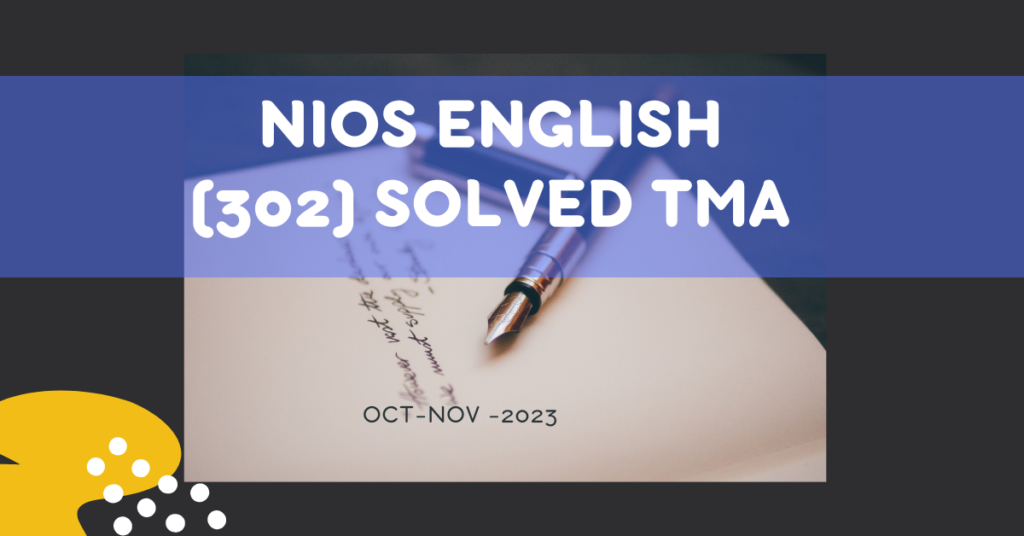Do you need NIOS solved Assignment? You are at the right place. Below is the complete NIOS Political science (317) Solved Tutor Marked Assignment (TMA) for the senior secondary course. Also, you can download PDF NIOS Political Science (317) solved assignment(TMA) for the 2020-2021 session.
Free NIOS solved Political Science Assignment for class -12.
Session 2020-2021
English Medium.
1. Answer any one of the following questions in about 40-60 words.
(b) State two situations in which the ‘President’s Rule’ can be extended beyond one year.
Answer: The two situations in which the ‘President’s Rule can be extended beyond one year are:
(a) a National Emergency is already in operation; or if
(b) the Election Commission certifies that the election to the State Assembly cannot be held.
2. Answer any one of the following questions in about 40 to 60 words.
(a) How do the provisions of Women Reservation enhance the role of women in Indian
Politics?
Answer: Women constitute nearly half of the entire Indian population. But the condition of women in India is miserable, due to illiteracy, poverty, and backward social values. Keeping in view the prevalent circumstances, reservation for the women was started. Under the Panchayati Raj system, women’s seats have been reserved at both the Panchayat level, and the block & district levels. Some political parties are also debating the issue of giving at least 30% tickets to women candidates for contesting elections of state legislative assembly and also for the parliamentary elections.
3. Answer any one of the following questions in about 40 to 60 words.
(b) Identify any two factors that cause environmental degradation.
Answer: Two factors that cause environmental degradation are:
Population Growth: Our growing population is putting pressure on land, leading to poor quality of productivity, deforestation (the loss of forest land so necessary for ecological balance and extinction of wildlife leading to an imbalance in the ecological order, loss of wildlife heritage and ultimately dwindling of several species.Industrialization: Industrialization coupled with the development of the means of transport and communication has not only polluted the environment but also has led to the shrinking of natural resources. The increasing level of heat fluxes, carbon dioxide and particulate, radioactive nuclear wastes, and the like create environmental hazards. On the other hand, the consumption of conventional sources of energy leads to the loss of natural resources.
4. Answer any one of the following questions in about 100 to 60 words.
(b) Evaluate the role of citizens in the process of good government.
Answer: People’s participation is given increasing priority in the scheme of governance. It is recognized that people’s involvement in decision-making and decision implementation would act as:
a) A check on indifferent and inefficient bureaucracy. In other words, people could act as a pressure on the administration to act and act in time.
b) Instruments for a responsive and accountable administration.
c) A medium of development administration and self-government.
d) A mobilizer and user of local resources for local development.The people can perform this role either by becoming a member of any social organization or interest and pressure groups or welfare organization or a political party or by becoming a part of bureaucracy and government at national, regional or local levels.
5. Answer any one of the following questions in about 100 to 150 words
(a) What are the major hindrances to good governance?
Answer: Hindrances to Good Governance:
a) Corruption: Corruption is universal disease-causing harm to the people and government almost everywhere in the world. However, in the countries like India, it has assumed the shape of cancer. At times the political leaders have expressed their helplessness to contain corruption by arguing that corruption is a worldwide phenomenon. But the question of probity and corruption is getting a little more attention than earlier.
b) Population Growth: one finds that development efforts have failed to eliminate poverty, unemployment, and illiteracy and to secure to all ‘citizens equitable access to even primary education and health, food, water, and a house. From a population of about 35 crores at the time of India’s Independence to more than 130 crores now is a cause for concern. The phenomenal growth in numbers requires resources to sustain them. There is an increasing demand for land, air, and water resources. Providing adequate educational and health facilities, food, shelter, and employment to the growing numbers is a difficult task
c) Culture of Violence: Strikes, riots, terror attacks and other this type of harmful culture of violence are a barrier to good governance. The government can focus on economic, social, and political development if it is free from the concerns of a threat to public safety and security in terms of life and property. Moreover, terrorism is also the greatest threat to the rule of law because terror replaces the law or seeks to subvert the law. before any government in India.
You may also like:
NIOS English Solved TMA.
NIOS Home Science Solved TMA.
NIOS Business Studies Solved TMA
6. Prepare any one project of the given below:
Undertake a survey of 20 families in your locality. Find out the educational level, working hours, nature of work of women vis a-vis men. What conclusions do you draw on the basis of this survey related to the following issues:
(i) Status of women in the family
(ii) Economic contribution by the women
(iii) Level of gender discrimination
Suggest ways and means to improve the existing scenario.
Answer: Women status in Indian Society:
The status of women in India’s isn’t uniform. The conventional roles of women have experienced a few changes because of financial needs and a few endeavours were made to change the status of women in the society.
i) Status of women in the family: Any society consists of men and of women. It is equally important to look at how the two groups of people interact, as well as at the roles and expectations each group has of the other. Most families in India, irrespective of their caste and religion, are patrilineal. Even though a mother has a vital part to play in the child’s life, major decisions regarding his/her future and that of others in the family are taken by the men in the family. Even though a mother has a vital part to play in the child’s life, major decisions regarding his/her future and that of others in the family are taken by the men in the family.
ii) Economic contribution by the women: Woman acts as the humble manager of the family income. It is her responsibility to secure the maximum return from every rupee spent. The woman in the family also contributes to the family income through her own earning within or outside the home. She has a positive contribution to the family income by the work.
iii) Level of gender discrimination: Gender discrimination in an Indian family is higher. Within the Indian patriarchal family system, dominating and controlling social functions are prescribed for the males, whereas supportive functions are prescribed for the females. By birth, males are caretakers of resources, performing the functions of earners, on the other hand, females are family caretakers performing the functions of child nurturing, caring for the aged, and running the household.
Please Share:
(






